Skip to comments.
Common Creationist Arguments - Pseudoscience
http://www.stardestroyer.net/Creationism/Arguments/Pseudoscience.shtml ^
Posted on 03/13/2002 4:47:26 AM PST by JediGirl
click here to read article
Navigation: use the links below to view more comments.
first previous 1-20 ... 1,081-1,100, 1,101-1,120, 1,121-1,140 ... 2,461-2,474 next last
To: Doctor Stochastic
The Univac 1101 was the thirteenth machine design in that series. Followed by 1102, 1103....
To: VadeRetro
Basic reality, you look at any sort of a real river which is more than a mile wide, the Volga, Amazon... and you expect it to be shallow, at least at the edges. I mean, you don't expect to take three steps into the Volga and then go straight down 1500'. Nonetheless, that's precisely what you see on the edges of the Grand Canyon, is this unbelievable vertical drop of 1500 or 2000 feet, sharp pristine edges everywhere you look mesas which would have been 2000' below the surface with sharp, pristine edges and features everywhere... Rivers just don't do that sort of thing. Moreover the topology of the river is basically fractal, with sinuous rills just everywhere and thousands of micro-tributaries if you want to call them that; you don't see that sort of thing with real rivers.
Basic bottom line, the Grand Canyon was blasted straight out of the rock by a fantastic electrical discharge between this planet and some other cosmic body, a comet, asteroid, or another planet, and most of the material from the canyon was either vaporized or blasted straight out into space. Real interesting spectacle, but you'd have wanted to watch from a considerable distance...
To: Doctor Stochastic
False. Odds are not products of probabilities. Please explain…
Selection creates dependencies.
Sir, with all due respect, I believe your argument to be dependencies create selection.
To: medved
Number one, the river is wearing away at the rock -- at no point was the river 2000 feet deep; it may have only been 20 feet deep, but over the years the water wore away at the rock and the canyon formed. Also, the river bed changed course numerous times over millions of years, causing the various channels to be cut. One need not postulate any other mechanism than water erosion and time.
To: gore3000
it seems to me that what we have is a designer who used some parts of his "building blocks" in different places with as far as evolutionary theory goes no sense at all Seems to you based on what? Where are the chimeras?
so if both man and chimp have it, then the other apes should have it too
Please explain, I don't see this at all.
To: edsheppa
Ah yes. Clearly if one doesn't know everything then one doesn't know anything. Although there doesn't exist any fossil evidence for variation by small mutation, proponents of evolution can usually come up with a story to explain the developmental stages of any particular creature. In the case of the woodpecker's tongue, they can't even come up with a remotely plausible story.
The historical evidence for evolution also shows a remarkable sequence of misrepresentations or outright frauds, which I've highlighted. (All of these "scientific facts" were taught ot me in 10th grade biology in the late '70s, and I'm not very happy about being lied to)
* The Miller-Urey Experiment: evolutionists claim that it demonstrated the emergence of primitive life from Earth’s early atmosphere. Wells shows why, for at least a decade, most geochemists have been convinced it did nothing of the sort. * Darwin’s "Tree of Life," showing the branching of species from a common ancestor: supposedly reconstructed from a large and growing body of fossil and molecular evidence, it has actually been "uprooted and turned upside down" by the evidence
* Similiar bone structures in vertebrate limbs (e.g., a bat's wing, a porpoise's flipper, a horse's leg, a human hand): Darwinists claim they indicate origin in a common ancestor -- but Wells points out the faulty logic underlying this claim, and the gaping hole in the theory built around it
* "Haeckel's embryos": evolutionists use these famous drawings of similarities in early embryos to argue that amphibians, reptiles, birds and humans are all descended from a fish-like animal, and that embryonic development "recapitulates" the stages of evolution. Trouble is, Wells easily proves, the drawings are fakes, misrepresenting the embryos the purport to show! (And they're deceptive in another crucial sense, too)
* Archaeopteryx, a fossil bird with teeth in its jaws and claws on its wings: for over a century, Darwinists have called this the "missing link" between ancient reptiles and modern birds, and "unimpeachable" evidence for evolution. But Wells demonstrates that "paleontologists now agree that Archaeopteryx is not the ancestor of modern birds, and its own ancestors are the subject of one of the most heated controversies in science. The missing link, it seems, is still missing."
* Peppered moths on tree trunks: most textbooks illustrate natural selection with photographs of the two varieties of peppered moths resting on light- and dark-colored tree trunks. But Wells explains why "biologists have known since the 1980s that the classical story has some serious flaws" -- beginning with the fact that peppered moths in the wild don't even rest on tree trunks, and that the textbook photos have been staged!
* "Darwin's finches" on the Galapagos Islands: legend has it that they were instrumental in helping Darwin to formulate his theory of evolution, and that field observations in the 1970s provided evidence for the theory by showing how natural selection affects the birds' beaks. Both claims are patently false, Wells demonstrates
* Four-winged fruit flies: Wells explains why they're "no better than a two-headed calf in a circus sideshow" for proving that genetic mutations supply the raw materials for evolution. Why, then, has it become popular to feature them in textbooks and public presentations defending Darwin's theory? Because they help conceal a deeper problem with the evidence
* A "branching tree" pattern of horse fossils: since the '50s, Darwinists have campaigned to replace the old "linear" icon of horse evolution -- which suggested that evolution may have been "directed" by some supernatural or internal agency -- with this one. But, as Wells shows, the new icon isn't an inference from the evidence, but an imposition of materialist philosophy on it
* From Ape to Human: a series of drawings showing a knuckle-walking ape evolving through a series of intermediate forms into an upright human being. Wells calls this "the ultimate icon" of evolution, and shows why the pitifully meager "evidence" for it lends itself to interpretations that are "heavily influenced by personal beliefs and prejudices"
Then there are the other fraudulent "fossils" like Nebraska Man and Piltdown Man.
To: Aquinasfan
Ten questions to ask your biology teacher about evolution.
1. ORIGIN OF LIFE. Why do textbooks claim that the 1953 Miller-Urey experiment shows how life's building blocks may have formed on the early Earth -- when conditions on the early Earth were probably nothing like those used in the experiment, and the origin of life remains a mystery?
2. DARWIN'S TREE OF LIFE. Why don't textbooks discuss the "Cambrian explosion," in which all major animal groups appear together in the fossil record fully formed instead of branching from a common ancestor -- thus contradicting the evolutionary tree of life?
3. HOMOLOGY. Why do textbooks define homology as similarity due to common ancestry, then claim that it is evidence for common ancestry -- a circular argument masquerading as scientific evidence?
4. VERTEBRATE EMBRYOS. Why do textbooks use drawings of similarities in vertebrate embryos as evidence for their common ancestry -- even though biologists have known for over a century that vertebrate embryos are not most similar in their early stages, and the drawings are faked?
5. ARCHAEOPTERYX. Why do textbooks portray this fossil as the missing link between dinosaurs and modern birds -- even though modern birds are probably not descended from it, and its supposed ancestors do not appear until millions of years after it?
6. PEPPERED MOTHS. Why do textbooks use pictures of peppered moths camouflaged on tree trunks as evidence for natural selection -- when biologists have known since the 1980s that the moths don't normally rest on tree trunks, and all the pictures have been staged?
7. DARWIN'S FINCHES. Why do textbooks claim that beak changes in Galapagos finches during a severe drought can explain the origin of species by natural selection -- even though the changes were reversed after the drought ended, and no net evolution occurred?
8. MUTANT FRUIT FLIES. Why do textbooks use fruit flies with an extra pair of wings as evidence that DNA mutations can supply raw materials for evolution -- even though the extra wings have no muscles and these disabled mutants cannot survive outside the laboratory?
9. HUMAN ORIGINS. Why are artists' drawings of ape-like humans used to justify materialistic claims that we are just animals and our existence is a mere accident -- when fossil experts cannot even agree on who our supposed ancestors were or what they looked like?
10. EVOLUTION A FACT? Why are we told that Darwin's theory of evolution is a scientific fact -- even though many of its claims are based on misrepresentations of the facts?
To: Aquinasfan
2. DARWIN'S TREE OF LIFE. Why don't textbooks discuss the "Cambrian explosion," in which all major animal groups appear together in the fossil record fully formed instead of branching from a common ancestor -- thus contradicting the evolutionary tree of life? A magazine cover article a few years back was titled something like "The Big-Bang of Evolution (the Cambrian Explosion)" as if that somehow or other wasn't an oxymoron. Kind of like "the big sex orgy of chastity" or some such.
To: Heartlander
False. Odds are not products of probabilities.
Please explain...
What are the chances that a randomly chosen voter voted for Bush? About 1/2. What are the chances a voter is fiscally conservative? About 1/2. What are the chances a voter voted for Bush AND is fiscally conservative? The answer is not 1/4.
1,109
posted on
03/21/2002 9:30:16 AM PST
by
Lev
To: Junior
Aside from the basic impossibility of a 20-mile-wide river wearing its edges straight downward 1500', there is also the problem of the mesas. Since the mesas would have been worn glassy smooth had they ever been under water, a person claiming the river created the canyon also has to believe that God or Chuck Darwin or somebody created the mesas AFTER the river had worn the canyon down to its present river bed. Pretty far fetched.
To: Lev
odds [odz ]
plural noun 1. chances of something happening: the likelihood or probability that something will occur, sometimes expressed as a ratio such as 10 to 1 The odds are that you'll never make it.
Note: the statement 'the odds are that you'll never make it' was an actual part of the definition. What are the odds?!
To: Junior
One need not postulate any other mechanism than water erosion and time. You never saw--heard of a drying--shrinking crack? Ever see one in mud??
One need not postulate any other mechanism than water erosion and time---
...you believe that?
Is that how you learn--think--teach..."one need not"?
No wonder you believe this evolution infantile nonsense---garbage!
To: Heartlander
Do you agree that product of probabilities is not always the answer?
1,113
posted on
03/21/2002 9:56:07 AM PST
by
Lev
To: Heartlander
This is not the place for a discussion of elementary probability theory. You should take a good college course in introductory probability theory. There are also sites on the Web that have good explanations.
Short explanation: odds for are the ratio of "favorable" cases to "unfavorable" caes (odds against is the reciprocal). Probability is the ration of "favorable" cases to total cases. For example in flipping a fair coin, the probability of getting heads is 1/2 but the odds of getting heads is 1/1. On an ordinary die, the probability of throwing an ace is 1/6 but the odds against are 5/1.
To: medved
The lack of fulgurites would seem to be evidence against an electrical event.
To: medved
Dunno about that.
From Grand Canyon Explorer:
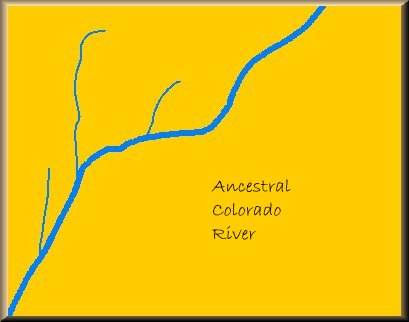 Prior to about 35 million years ago the ancestral Colorado River flowed across a vast plain, along a course very similar to that of today. Prior to about 35 million years ago the ancestral Colorado River flowed across a vast plain, along a course very similar to that of today.
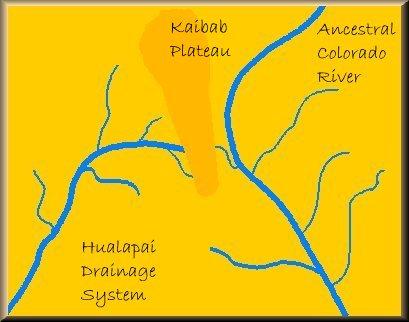 When the Kaibab Plateau began to uplift approximately 35 million years ago the river was diverted to the southeast because it could not cross newly created barrier. The new course for the river now flowed out to the Gulf of Mexico instead of to the Pacific Ocean. The old course on west side of the Kaibab Plateau, the Hualapai Drainage System, continued to be a major drainage for the plateau itself and the regions west of it. When the Kaibab Plateau began to uplift approximately 35 million years ago the river was diverted to the southeast because it could not cross newly created barrier. The new course for the river now flowed out to the Gulf of Mexico instead of to the Pacific Ocean. The old course on west side of the Kaibab Plateau, the Hualapai Drainage System, continued to be a major drainage for the plateau itself and the regions west of it.
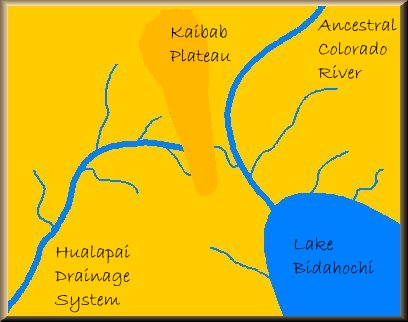 At some point around 12 million years ago, the river's course to the Gulf of Mexico became blocked and an enormous lake, know referred to as Lake Bidahochi, was formed as a result. At some point around 12 million years ago, the river's course to the Gulf of Mexico became blocked and an enormous lake, know referred to as Lake Bidahochi, was formed as a result.
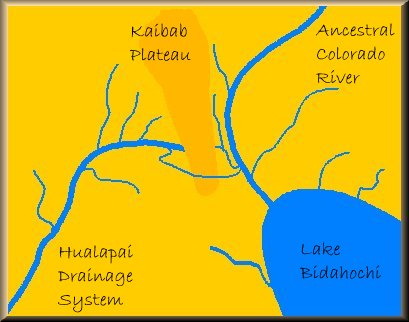 Meanwhile, on the western side of the Kaibab Plateau, a process known as "headwater erosion" began eating its way through the southern portion of the plateau. After millions of years this erosional process allowed the Hualapai system to break through the barrier created by the uplifted plateau and rejoin the ancestral Colorado. Meanwhile, on the western side of the Kaibab Plateau, a process known as "headwater erosion" began eating its way through the southern portion of the plateau. After millions of years this erosional process allowed the Hualapai system to break through the barrier created by the uplifted plateau and rejoin the ancestral Colorado.
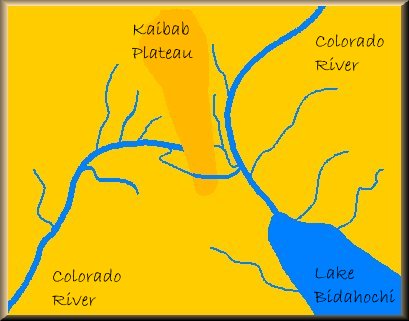 Once the break-through was complete the ancestral Colorado River began to follow the new course becuase of its steeper and more desirable descent. The waters of Lake Bidahochi began to drain through the new course as well and the result is the gorge through which the Little Colorado River now flows. The combined flow of the Colorado River and the Little Colorado River west of their confluence continued to widen and deepen the course and created the Grand Canyon. Once the break-through was complete the ancestral Colorado River began to follow the new course becuase of its steeper and more desirable descent. The waters of Lake Bidahochi began to drain through the new course as well and the result is the gorge through which the Little Colorado River now flows. The combined flow of the Colorado River and the Little Colorado River west of their confluence continued to widen and deepen the course and created the Grand Canyon.
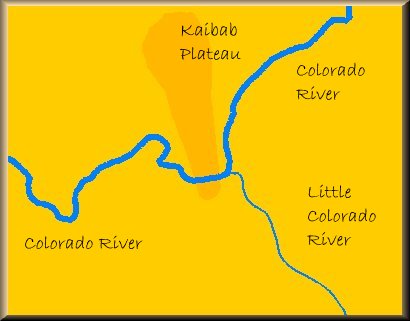 After Lake Bidahochi was drained the space that it once occupied was replaced by the Little Colorado River drainage system. After Lake Bidahochi was drained the space that it once occupied was replaced by the Little Colorado River drainage system.
|
This seems to imply that water erosion and 35 million years is more than sufficient to work the magic we call the Grand Canyon.
To: medved
I asked you about the Gorge of the Brahmaputra. It bisects the Himalayas before dumping into the Bay of Bengal.
What's faster, water erosion or the tectonic raising of the landscape? Answer: water erosion, always.
Say a pre-existing river cuts right across where a tectonic compression is raising a mountain ridge. The rising of the land dams the water a bit. You get a bit of a lake, with a natural spillway in the old riverbed where the water flows over the rising hump.
The downstream side of the hump wears away faster than the river bottom upstream or downstream. What happens? The "spillway" erodes back to the "lake" and it all gives out with a big rush.
You can see this sort of thing everywhere. In the Sweetwater Valley, which I visited to reseach a book, there's a spectacular cut through a ridge of bare rock.

Note that, if the ridge is there before the river forms, the river channel simply forms in such a way to go around the ridge and that's that.
The Grand Canyon is not a problem for mainstream science. It's a problem for all the psychoceramics who would like to explain it any other way.
To: Doctor Stochastic;Lev
Gentlemen,
Empirical data is used in genetics to compute probabilities all the time. It is interesting that you sight gambling to dispute the probabilities posed above. Evolution is just a big gamble after all and it continues to try it’s luck on different machines all the time – but the house wins.
The article that these posts are supposed to be based upon even site a probabilities link. It doesn’t work though – what are the chances?…
To: Junior
When the Kaibab Plateau began to uplift approximately 35 million years ago the river was diverted to the southeast because it could not cross newly created barrier. Live and learn. I didn't think tectonic forces ever won the race against water erosion.
But, as someone will no doubt quickly point out, I'm just a dilettante here.
(But that someone has a question or two of his own to answer.)
To: medved
Just to doublecheck the numbers, you've put the average depth of the Grand Canyon at 2000 feet (I've heard some section are as much as a mile deep, but 2000 feet sounds like a good average). Over 35,000,000 years the river would only have to wear an average of 0.017 mm of rock per year -- thinner than a sheet of paper. It seems to me that natural water erosion should be more than sufficient to account for the canyon we see today. Your theory is interesting and all, but it lacks any evidence of a static electrical discharge (fused sand, etc.) necessary to corroborate it; and without that evidence the other hypothesis (water erosion), which does have evidence supporting it, appears to be the best explanation for the canyon we have.
Navigation: use the links below to view more comments.
first previous 1-20 ... 1,081-1,100, 1,101-1,120, 1,121-1,140 ... 2,461-2,474 next last
Disclaimer:
Opinions posted on Free Republic are those of the individual
posters and do not necessarily represent the opinion of Free Republic or its
management. All materials posted herein are protected by copyright law and the
exemption for fair use of copyrighted works.
FreeRepublic.com is powered by software copyright 2000-2008 John Robinson
 Prior to about 35 million years ago the ancestral Colorado River flowed across a vast plain, along a course very similar to that of today.
Prior to about 35 million years ago the ancestral Colorado River flowed across a vast plain, along a course very similar to that of today. When the Kaibab Plateau began to uplift approximately 35 million years ago the river was diverted to the southeast because it could not cross newly created barrier. The new course for the river now flowed out to the Gulf of Mexico instead of to the Pacific Ocean. The old course on west side of the Kaibab Plateau, the Hualapai Drainage System, continued to be a major drainage for the plateau itself and the regions west of it.
When the Kaibab Plateau began to uplift approximately 35 million years ago the river was diverted to the southeast because it could not cross newly created barrier. The new course for the river now flowed out to the Gulf of Mexico instead of to the Pacific Ocean. The old course on west side of the Kaibab Plateau, the Hualapai Drainage System, continued to be a major drainage for the plateau itself and the regions west of it. At some point around 12 million years ago, the river's course to the Gulf of Mexico became blocked and an enormous lake, know referred to as Lake Bidahochi, was formed as a result.
At some point around 12 million years ago, the river's course to the Gulf of Mexico became blocked and an enormous lake, know referred to as Lake Bidahochi, was formed as a result. Meanwhile, on the western side of the Kaibab Plateau, a process known as "headwater erosion" began eating its way through the southern portion of the plateau. After millions of years this erosional process allowed the Hualapai system to break through the barrier created by the uplifted plateau and rejoin the ancestral Colorado.
Meanwhile, on the western side of the Kaibab Plateau, a process known as "headwater erosion" began eating its way through the southern portion of the plateau. After millions of years this erosional process allowed the Hualapai system to break through the barrier created by the uplifted plateau and rejoin the ancestral Colorado. Once the break-through was complete the ancestral Colorado River began to follow the new course becuase of its steeper and more desirable descent. The waters of Lake Bidahochi began to drain through the new course as well and the result is the gorge through which the Little Colorado River now flows. The combined flow of the Colorado River and the Little Colorado River west of their confluence continued to widen and deepen the course and created the Grand Canyon.
Once the break-through was complete the ancestral Colorado River began to follow the new course becuase of its steeper and more desirable descent. The waters of Lake Bidahochi began to drain through the new course as well and the result is the gorge through which the Little Colorado River now flows. The combined flow of the Colorado River and the Little Colorado River west of their confluence continued to widen and deepen the course and created the Grand Canyon. After Lake Bidahochi was drained the space that it once occupied was replaced by the Little Colorado River drainage system.
After Lake Bidahochi was drained the space that it once occupied was replaced by the Little Colorado River drainage system.